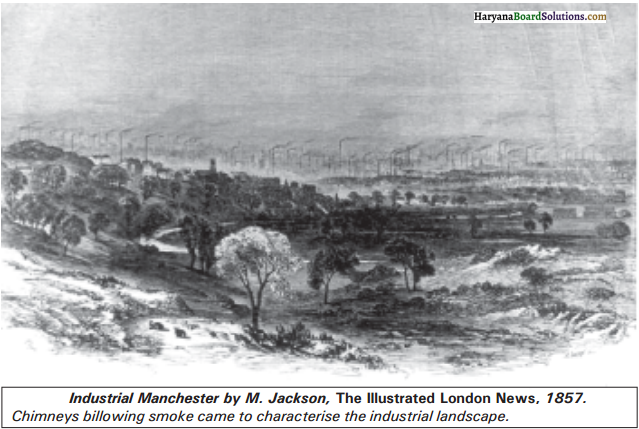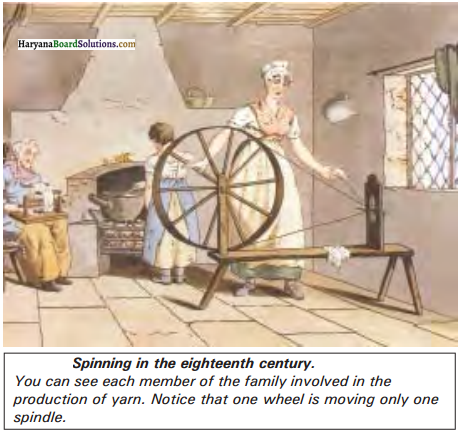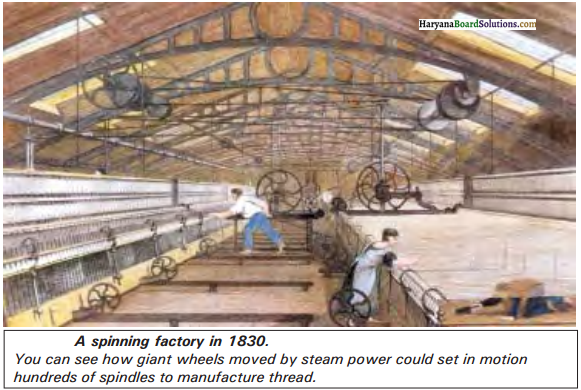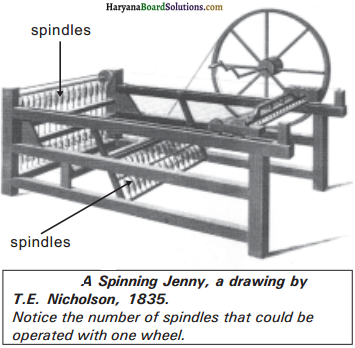Haryana State Board HBSE 10th Class Social Science Solutions History Chapter 4 The Age of Industrialisation Textbook Exercise Questions and Answers.
Haryana Board 10th Class Social Science Solutions History Chapter 4 The Age of Industrialisation
HBSE 10th Class History The Age of Industrialisation Intext Questions and Answers
Activity (Page No. 83)
The Age Of Industrialisation HBSE 10th Class Question 1.
The way in which historians focus on industrialisation rather than on small workshops is a good example of how what we believe today about the past is influenced by what historians choose to notice and what they ignore. Note down one event or aspect of your own life which adults such as your parents or teachers may think is unimportant, but which you believe to be important.
Answer:
Students may attempt themselves.
The Age Of Industrialisation Class 10 Questions And Answers Question 2.
Look at text book figs. 4 and 5. Can you see any difference in the way the two images show industrialisation ? Explain your view briefly.
Answer:
(i) In figure 4, a Lancashire cotton mill is glowing with electricity in the twilight, which adds to the beauty of the city.

(ii) On the other hand, if we see we can notice the chimneys of industrial units in Manchester are blowing, and the smoke which is thus emitted characterises the industrial landscape. It symbolises environmental pollution. Therefore, the main difference between both the figures is that while figure 4 is indicating beauty, figure 5 is indicating pollution.

![]()
Activity (Page No. 85)
Age Of Industrialisation HBSE 10th Class Question 1.
Imagine that you are a merchant writing back to a salesman who has been trying to persuade you to buy a new machine. Explain in your letter what you have heard and why you do not wish to invest in the new technology.
Answer:
Dear salesman, I have heard that machines require large capital investment. Their maintenance is expensive. Machines are oriented for producing uniform and standardised goods for a mass market, but the demand in the market is often for goods with intricate designs and specific shapes. Therefore, I do not wish to invest in new technology.
Thanks for your approach.
John Patrick
Activity (Page No. 89)
On a map of Asia, find and draw the sea and land links of the textile trade from India to Central Asia, West Asia and South-east Asia.
Answer:

Discuss (Page No. 87)
Age Of Industrialisation Class 10 HBSE Question 1.
Look at Figs. 3, 7 and 11. Then re-read source B. Explain why many workers were opposed to the use of the Spinning Jenny.
Answer:
Spinning Jenny was the machine that made it possible to yam many spindles from one wheel. Whereas, in earlier times, one wheel could yam only one spindle. At that time, all members of a family were employed. But, productivity increased due to Spinning Jenny and so, many spindles could be yarned at one time from one wheel. This led to increase in unemployment. Therefore, many workers opposed to the use of Spinning Jenny.



![]()
HBSE 10th Class History The Age of Industrialisation Textbook Questions and Answers
The Age Of Industrialisation Class 10 HBSE Question 1.
Explain the following:
(a) Women workers in Britain attacked the Spinning Jenny.
(b) In the seventeenth century, merchants from towns in Europe began employing peasants and artisans within the villages.
(c) The port of Surat declined by the end of the eighteenth century.
(d) The East India Company appointed gomasthas to supervise weavers in India.
Answer:
Spinning Jenny was invented by James Hargreaves in the year 1764. This machine speeded up the spinning process and reduced labour demands.
(a) Women workers in Britain, attacked the Spinning Jenny because by turning one single wheel, a worker could set in motion, a number of spindles and spin’ several threads at the same time. This increased not only the productivity but also led to unemployment of women, who survived on hand spinning. Therefore, angry women attacked the Spinning Jenny.
(b) In the seventeenth century, with the expansion of world trade and the acquisition of colonies in different parts of the world, the demand for goods began growing. But, merchants could not expand production within towns. This was because, here, urban crafts and trade guilds were powerful. Rulers granted different guilds the monopoly right to produce and trade in specific products. It was, therefore, difficult for new merchants to set up business in towns. So, they turned to the countryside, supplying money to peasants and artisans, persuading them to produce for an international market.
(c) The port of Surat on the west coast of India was the major port to handle the Indian foreign trade with the west, before the age of machines. It linked India to the Gulf and the Red Sea ports. But towards the end of the 18th century, various European companies gradually gained power by securing the monopoly rights of trade. They developed and patronised their own ports like Bombay and Calcutta. This resulted in a decline of the old port of Surat, through which local merchants had operated. Exports from this port fell dramatically. In the last years of the seventeenth century, the gross value of trade that passed through Surat had been ₹16 million. In 1740s, it had slumped to ₹3 million.
![]()
(d) The Indian weavers produced coarse cloth for the East India Company as well as the French, Dutch and Portuguese. The East India Company wanted to assert a monopoly right to trade. It tried to develop a system of management and control that would eliminate competition and ensure regular supplies of Indian goods, especially Indian cotton and silk goods. In order to establish a direct control over the weavers, it decided to eliminate the existing traders and brokers. With this purpose in view, the East India Company appointed paid servants called the gomasthas to supervise weavers, collect supplies, and examine the quality of clothes.
Age Of Industrialisation Class 10 Solutions HBSE Question 2.
Write True or False against each statement:
(a) At the end of the nineteenth century, 80 per cent of the total workforce in Europe was employed in the technologically advanced industrial sector.
(b) The international market for fine textiles was dominated by India till the eighteenth century.
(c) The American Civil War resulted in the reduction of cotton exports from India.
(d) The introduction of the fly shuttle enabled handloom workers to improve’g|heir productivity.
Answer:
(a) False
(b) True
(c) False
(d) True.
Age Of Industrialisation Class 10 Questions And Answers HBSE Question 3.
Explain what is meant by proto-industrialisation.
Answer:
‘Proto’ word indicates the first or early form of something. By proto industrialisation, historians refer to the period before industrialisation. The presence of cottage industries was named as Proto-industrialisation. It was a mixture of production in factories and cottage industries.
Discuss:
Question 1.
Why did some industrialists in nineteenth-century Europe prefer hand labour over machines ?
Answer:
Some European industrialists in nineteenth-century preferred hand labour over machines due to the following reasons:
(i) In Victorian Britain, there was no shortage of human labour. Poor peasants and workers moved to the cities in large numbers in search of jobs, waiting for work. So, industrialists had no problem of labour shortage or high wage costs. They did not want to introduce machines that made them get rid of cheaply available human labour and required large capital investment.
(ii) In many industries, like gas works and breweries, book-binding and printing, etc. the demand for labour was seasonal. Therefore, industrialists usually preferred hand labour in all such industries, employing workers for the season.
(iii) Machines were oriented to produce uniform standardised goods for a mass market. But, the demand in the market was often for goods with intricate designs and specific shapes.
(iv) Many articles like hammers, axes, etc. required human skill, not mechanical technology, to produce.
(v) In Victorian Britain, the aristocrats and the bourgeoisie preferred things produced by hand. Handmade products symbolised refinement and class. They were better finished, individually produced and carefully designed.
![]()
Question 2.
How did the East India Company procure regular supplies of cotton and silk textiles from Indian weavers?
Answer:
1. Appointment of Gomastha: The East India Company appointed Gomastha to supervise weavers, collect supplies, and examine the quality of cloth.
2. Monopoly over Company Weavers: East India Company prevented company weavers from dealing with other buyers. One way of doing this was through the system of advances.
3. Loan availability for Weavers: Once an order was placed, the weavers were given loans to purchase the raw material for their production. Those, who took loans, had to hand over the cloth they produced to the Gomastha. They could not take it to any other trader. In this way, the company weavers were prevented from dealing with other buyers.
Question 3.
Imagine that you have been asked to write an article for an encyclopaedia on Britain and the history of cotton. Write your views using information from the entire chapter.
Answer:
Britain and History of Cotton:
The earliest factories in England came up by the 1730s, but it was only in the late eighteenth century, that the number of factories multiplied. Cotton was the first symbol of the new era in Britain. Its production boomed in the late nineteenth century. In 1760, Britain was importing 2.5 million pounds of raw cotton to feed its cotton industry. By 1787, this import increased to 22 million pounds. A series of inventions in the eighteenth century increased the efficacy of each step of the production process (carding, twisting, spinning and rolling).
They made possible, the production of stronger threads and yam. Richard Arkwright created the cotton mill. Growing at a rapid pace, cotton was the leading sector in the first phase of industrialisation, upto the 1840s. A cotton mill was set up in Lancashire in Britain. A spinning factory was set up in 1830s, in which giant wheels, moved by steam power, could set in motion hundreds of spindles to manufacture thread. James Hargreaves devised a Spinning Jenny which was used to speed up the spinning process.
Britain had successfully controlled and dominated the trade in cotton-raw materials, cotton fabrics, coarse or fine varieties. It had established markets all over its colonies for selling the Manchester-made cotton textiles, which were cheaper than the hand-made cotton clothes. Indian fine textiles were in great demand in Europe. The East India Company indebted Indian weavers and supervised them with the help of Gomasthas. This ensured regular supply of both, hand-made fine variety of cotton fabric, as well as raw cotton. In this way, Britain dominated the textile industries over the centuries.
![]()
Question 4.
Why did industrial production in India increase during the First World War?
Answer:
Industrial production in India increased during the First World War due to the following reasons :
- The war created a dramatically new situation.
- With British mills busy with war production to meet the needs of the army, Manchester imports into India declined.
- Suddenly, Indian mills had a vast home market to supply.
- As the war prolonged, Indian factories were called upon to supply war needs jute bags, cloth for army uniforms, tents and leather boots, horse and mule saddles and a host of other items.
- Many new factories were set up and old ones ran multiple shifts.
- Many new workers were employed and everyone was made to work for longer hours. Over the war years, industrial production boomed.
Knowledge Basket
Match the following terms of Column ‘A’ with suitable options from Column ‘B’.
| Column ‘A’ | Column ‘B’ |
| (a) ‘Proto’ | (i) an agent or a middleman between the merchant and weavers. |
| (b) Gomastha | (ii) A person employed by the Industrialist to get new recruits. |
| (c) Jobber | (iii) Indicating the first or early form of something. |
| (d) Fuller | (iv) an Indian soldier in the service of the British army. |
| (e) Sepoy | (v) A person who fulls, i.e. gathers cloth by pleating. |
Answer:
(a) → (iii)
(b) → (i)
(c) → (ii)
(d) → (v)
(e) → (iv)
Select any one industry in your region and find out its history. How has the technology changed? Where do the workers come from? How are the products advertised and marketed? Try and talk to the employers and some workers to get their views about the industry’s history.
Answer:
Do yourself with the help of your teacher.
Collect pictures of Spinning Jenny, Fly Shuttle, Steam Engine through Internet. Now paste them on a chart paper.
Answer:
Do yourself.